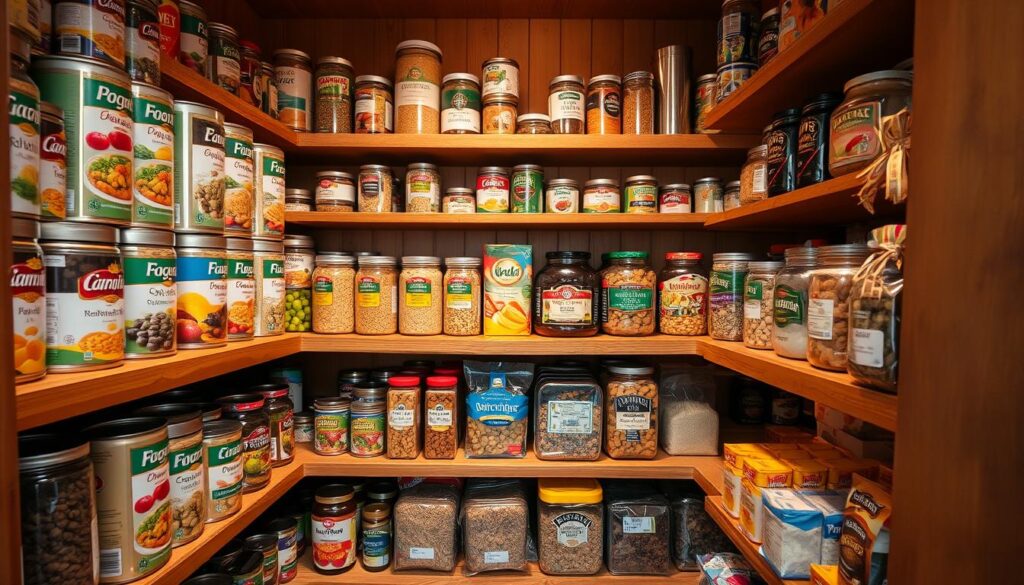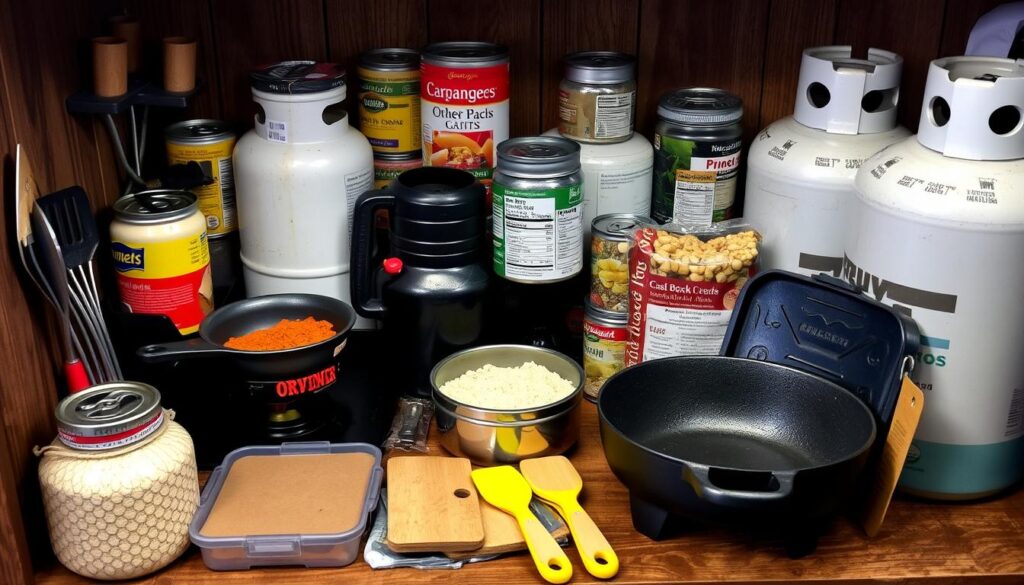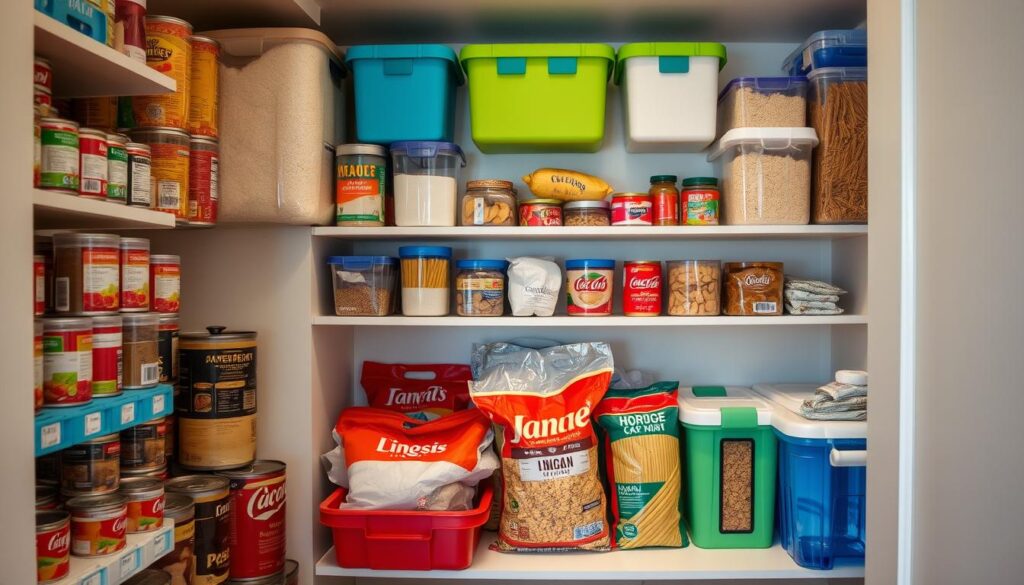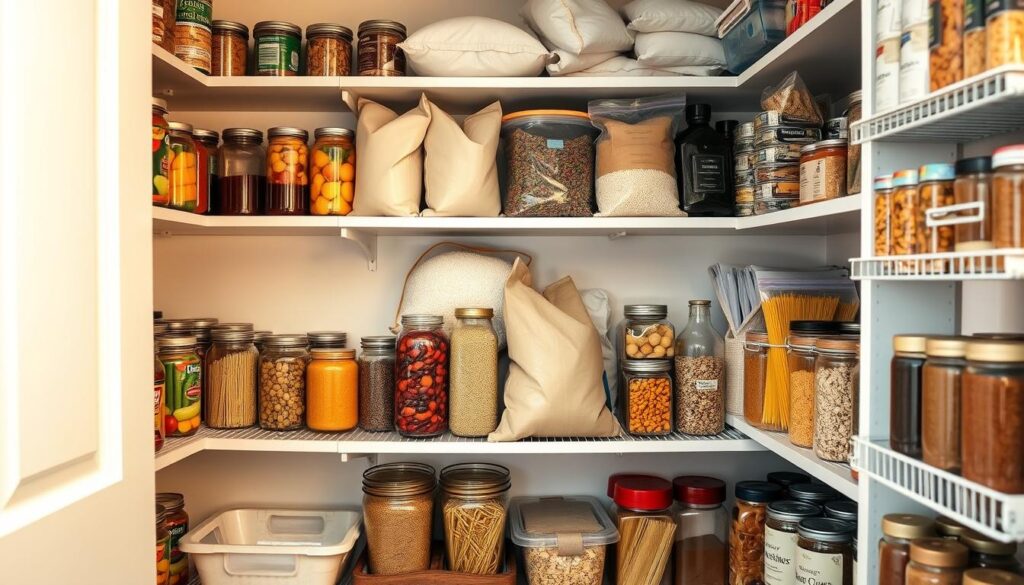
This website uses cookies to ensure you get the best experience on our website. View our Privacy Policy here.

Share this article via:
Please note: This website contains affiliate links. As an Amazon Associate, we earn from qualifying purchases at no additional cost to you.
.
I’ve lived through many hurricanes in Florida. The fear and uncertainty are tough, but a well-stocked pantry gives me peace. When storms hit and the lights go out, having the right food can keep my family safe and fed.
In this guide, I’ll show you how to build a strong emergency pantry. It’s key for surviving hurricanes, blizzards, or any disaster. With the right food, you can stay calm and keep your family safe.
Preparing for emergencies means having a pantry full of long-lasting foods. There are important guidelines for essential emergency food supplies.
Experts say to store at least three days’ worth of food. They suggest aiming for a week or more. Canned and dried foods last the longest, up to five years if stored right.
For a 2,000-calorie diet, each person needs about 5.5 ounces of protein and 2.5 cups of veggies. Also, 2 cups of fruits, 3 cups of dairy, and 6 ounces of grains are needed. Don’t forget to include special diets, infants, and pets in your planning.
A good emergency food supply should have a variety of nutrients. Canned, dried, and shelf-stable items like peanut butter and rice are good. They offer protein, carbs, and important vitamins and minerals.
“Canned foods are highlighted as having the longest shelf life among emergency food supplies.”
By following these guidelines, your family will be ready for any disaster or power outage. Always check and replace expired items to keep your emergency pantry fresh and nutritious.
Building an emergency food supply means focusing on items that last a long time. These items are key for survival during crises or natural disasters. They keep you and your family safe and fed.
Canned meats, fish, and beans are great for protein and can last years. Canned veggies and fruits give you important vitamins and minerals. Shelf-stable milk is a must for dairy needs. Ready-to-eat cereals, crackers, and nuts are perfect for quick snacks and meals.
Single-serve packaging is best for these items to avoid waste. Include condiments, instant meals, and comfort foods to make your emergency pantry more appealing.
Choose low-sodium options when you can to manage your intake better in stressful times. Buying in bulk from stores like Costco can save money. Stock up on canned tomatoes, pasta, and tuna.
| Non-Perishable Food Item | Shelf Life |
|---|---|
| Canned Meats, Seafood, and Low-Acid Canned Foods | 3 years beyond expiration date |
| High-Acid Canned Foods | 2 years past expiration date |
| Backpacker’s Pantry Emergency Survival Meal Kits | Up to 10 years |
| Mountain House Adventure Meals™ and Just in Case…® Products | 30-year shelf life and Taste Guarantee |
Stocking your pantry with these items ensures your family gets the nutrition they need in emergencies or disasters.

Having enough water is key during emergencies. Experts say to store at least one gallon of water per person per day. This is for drinking, cleaning, and cooking. So, a family of four should have 56 gallons for two weeks.
Choose food-grade containers or bottled water for storage. Clean bottles with a bleach solution and rinse well. Also, fill your bathtub with water before a storm to have extra.
If your water gets dirty, you can make it safe. Use bleach (16 drops per gallon) or water tablets. Boiling water for a minute is also a good way.
How much water you need daily depends on the weather and how active you are. The American Red Cross says to drink at least two quarts (half gallon) per person each day. In hot weather or when you’re active, you’ll need more to stay hydrated.
| Water Storage Method | Advantages | Disadvantages |
|---|---|---|
| Food-grade water containers | Reusable, durable, easy to store | Require regular sanitization |
| Pre-packaged bottled water | Convenient, long shelf life | Can be expensive, limited storage space |
| Bathtub water | Quick, readily available | Can be contaminated, limited supply |
Proper water storage and management are crucial. They ensure your family has enough water in emergencies. Always check and rotate your stored water to keep it safe and good to drink.
When disaster hits, a well-stocked pantry can be a lifesaver. It’s important to stock up on food, water, first aid, and important documents. Start by using digital tools to keep track of what you have and what you need.
Make a printed list of your emergency supplies. Buy extra non-perishable items when you shop. Look for sales to save money on shelf-stable foods and other essentials.
Consider teaming up with neighbors to buy in bulk. This way, you save money and help your community get ready for emergencies.
Building your emergency pantry takes time, but it’s worth it. With the right supplies and planning, you can face any challenge with confidence.
Having the right kitchen tools is key for emergency cooking. Manual can openers, bottle openers, and basic utensils are must-haves. They help you access and prepare food when the power goes out. A gas stove or propane grill is also great, as they don’t need electricity.
A good manual can opener is essential for emergencies. It lets you open canned goods without electricity. Also, a strong bottle opener is handy for opening water bottles and other sealed items. Keep basic tools like spatulas, tongs, and sharp knives ready to make cooking easier.
Having backup cooking methods is vital when the power is out. A gas stove or propane grill is perfect, as they work without electricity. Heavy-duty coolers, especially those for dry ice, are key for keeping food cold when the fridge is out. Don’t forget to freeze ice packs before hurricane season to avoid last-minute scrambles.
| Essential Kitchen Equipment | Benefits |
|---|---|
| Manual Can Opener | Allows access to canned goods without electricity |
| Bottle Opener | Useful for opening water bottles and other sealed containers |
| Gas Stove or Propane Grill | Provides alternative cooking method when power is out |
| Heavy-Duty Cooler | Stores perishable items when refrigeration is unavailable |
| Frozen Ice Packs | Maintain food freshness in coolers during power outages |

With the right emergency cooking equipment and manual kitchen tools, you’re ready for any power outage. These essential items are crucial for keeping your meals going during emergencies.
Keeping your pantry organized is key for emergency food storage solutions and quick access to important items. Here are some smart storage tips and pantry organization ideas to help you:
When evacuating, keep your emergency supplies in easy-to-carry containers for quick access. These smart storage strategies help keep your pantry organized and ready for any situation.

“Building a 3-month food stockpile is crucial for emergency preparedness. Stockpiling can help mitigate the impact of natural disasters and economic uncertainties.”
The secret to great pantry organization is to group items by function or category. Place items you use often at eye level. And always rotate your supplies based on expiration dates. With a bit of effort in smart storage and organization, you’ll have a well-stocked and easily accessible emergency food pantry.
Having a well-stocked pantry is smart for emergencies and can save you money on groceries. For long-term food storage, there are key practices to follow.
Keeping food fresh means controlling temperature and humidity. Aim for a cool, dry, and dark place. Basements, pantries, or rooms for food storage are best because they stay stable and dry.
It’s important to rotate your food to use the oldest first and avoid waste. Always check expiration dates. Put newer items at the back and older ones at the front. Canned goods with high acid last 12-18 months, while low-acid ones can last 2-5 years if stored right.
By sticking to these long-term food storage techniques and managing food expiration dates well, your emergency food will stay safe and good to eat when you need it.

When you’re getting ready for an emergency food supply, think about your family’s special needs. This includes allergies, medical conditions, or certain food preferences. Having the right emergency food can be a lifesaver during tough times.
For those with food allergies or intolerances, it’s smart to have allergen-free emergency supplies on hand. This means gluten-free, nut-free, or dairy-free options. People with diabetes need low-sodium, low-sugar foods too.
Remember to include medical supplies or supplements in your emergency kit. This includes insulin, syringes, and prescription meds. For babies, have enough formula, pureed food, and feeding tools.
If you have pets, make sure to have emergency food for special diets and their meds ready. Keeping your pets healthy is just as crucial as yours during emergencies.
| Category | Recommended Items | Shelf Life |
|---|---|---|
| Gluten-Free | Gluten-free crackers, cereals, pasta, and baking mixes | 1-2 years |
| Nut-Free | Nut-free protein bars, granola, and dried fruits | 1-2 years |
| Lactose-Free | Lactose-free milk, cheese, and yogurt alternatives | 6-12 months |
| Low-Sodium | Low-sodium canned goods, broths, and seasonings | 1-2 years |
| Sugar-Free | Sugar-free jams, syrups, and sweeteners | 1-2 years |
By planning ahead and stocking up on emergency food for special diets and allergen-free emergency supplies, you can make sure everyone in your family is ready for emergencies. This includes those with special dietary needs.
Effective emergency planning needs careful attention. Check your emergency food and supplies twice a year. This could be around daylight saving time changes.
Stay updated on local emergencies. Adjust your plan as needed. A well-stocked pantry is key for safety and comfort during disasters.
Creating a solid emergency plan takes time and effort. But it’s worth it for the peace of mind it brings. Follow the tips in this article to protect your family.
Start small and grow your emergency stockpile slowly. A little effort each week can help you prepare for any crisis. Use sales and discounts to save money. Stay alert, informed, and ready for emergencies.
Please note: This website contains affiliate links. As an Amazon Associate, we earn from qualifying purchases at no additional cost to you.
.
Share this article via:

This website uses cookies to ensure you get the best experience on our website. View our Privacy Policy here.